Children in migration - residence permits for family reasons
Data extracted: 6 November 2022.
Planned article update: November 2024.
Highlights
In 2022, 327 000 first residence permits for family reasons were issued in the EU to children aged less than 18 years who were not EU citizens. Among these children, 52 % were aged less than 5 years.
Moroccan, Albanian and Indian were the three most common citizenships in 2022 for first residence permits delivered for family reasons to children aged less than 18 years who were not EU citizens.
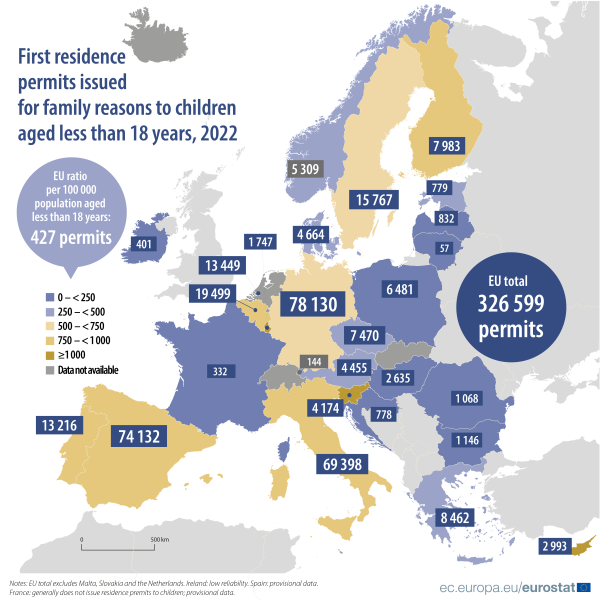
(number)
Source: Eurostat (migr_resfas) and (demo_pjan)
Among all migrants, children are a particularly vulnerable group who need special attention. Based on first residence permit statistics, this article focuses on one of the main indicators of immigration for children who are not European Union (EU) citizens: the number of children issued with a first residence permit for family reasons.
Family reasons for residence permits include family formation (such as marriages or adoptions) and reunification with family members already residing lawfully in an EU Member State. For more information, please consult (page 6 of) the main definitions and methodological concepts.
Residence permit statistics collected by Eurostat are based on the administrative steps taken to issue residence permits. It should be noted that, until reference year 2021, the compilation of residence permit statistics analysed by age and sex was voluntary; as such, data are not complete for all EU Member States and years presented in this article.
Full article
Latest information for the EU
In 2022, the total number of first residence permits issued in the EU for family formation and reunification reasons to children aged less than 18 years was 326 599 (excluding Malta, Slovakia and the Netherlands). As such, first residence permits issued for family reasons represented 61.8 % of all first permits issued to children in the EU. Another 201 838 first permits were issued to children for reasons other than family reasons: 16 478 for education-related reasons, 1 500 for employment reasons and 183 860 for other reasons. By comparison, for the same year the number of first-time asylum applicants [1] aged less than 18 years was 219 005.
Figure 1 shows that, in 2022, children aged less than 5 years accounted for 51.7 % of the number of first residence permits issued in the EU for family reasons to children aged less than 18 years. It also shows that the share of males (52.0 %) was somewhat higher than that of females (48.0 %). In comparison with the breakdown by sex of first-time asylum applicants aged less than 18 years (59.5 % for males in 2022 and 58.1 % on average from 2014 to 2022), the gender gap was narrower for first residence permits issued for family reasons to children aged less than 18 years.
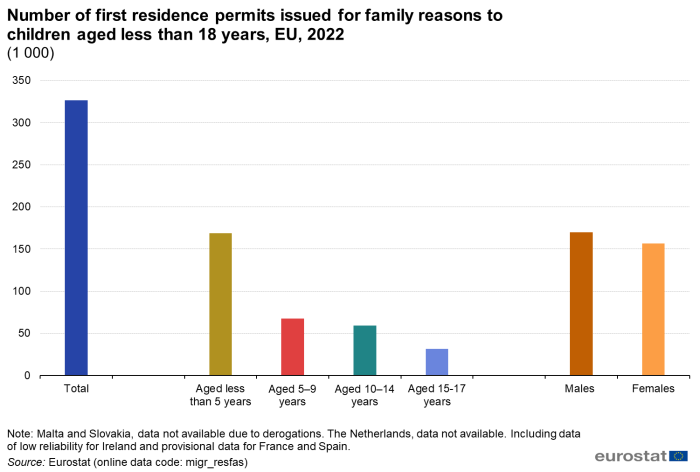
(1 000)
Source: Eurostat (migr_resfas)
In 2022, the EU Member States which issued the most residence permits for family reasons to children aged less than 18 years were Germany (23.9 % of the EU total), Italy (22.7 %) and Spain (21.2 %). They were followed at some distance by Belgium (6.0 %), Sweden (4.8 %) and Portugal (4.0 %) – see Table 1.
The number of first residence permits issued for family reasons to children aged less than 18 years relative to the population aged less than 18 years gives an indicator in relative terms of the weight of first residence permits delivered for family reasons to children. In 2022, this ratio averaged 427 per 100 000 population aged less than 18 years in the EU. This ratio was more than double the EU average in Spain, Slovenia, Luxembourg and Cyprus, peaking in the last of these at 1 730 per 100 000 population aged less than 18 years. In six EU Member States – Bulgaria, Poland, Ireland, Romania, Lithuania and France – this ratio was less than 100 per 100 000; it should be noted that France (where the lowest value of 2 per 100 000 was recorded), generally does not issue residence permits to children aged less than 18 years.
Table 1 also shows the share of children aged less than 5 years among all children aged less than 18 years having been issued with first residence permits for family reasons. In the EU, this averaged 51.7 % in 2022. By far the highest share for this indicator was observed in Belgium (63.3 %) and Italy (62.2 %). Luxembourg, Czechia, Slovenia and Sweden were the only other EU Member States to record shares above the EU average. By contrast, the lowest share of children aged less than 5 years among all children aged less than 18 years having been issued with first residence permits for family reasons was observed in Portugal (15.1 %), Ireland (9.7 %) and France (4.2 %).
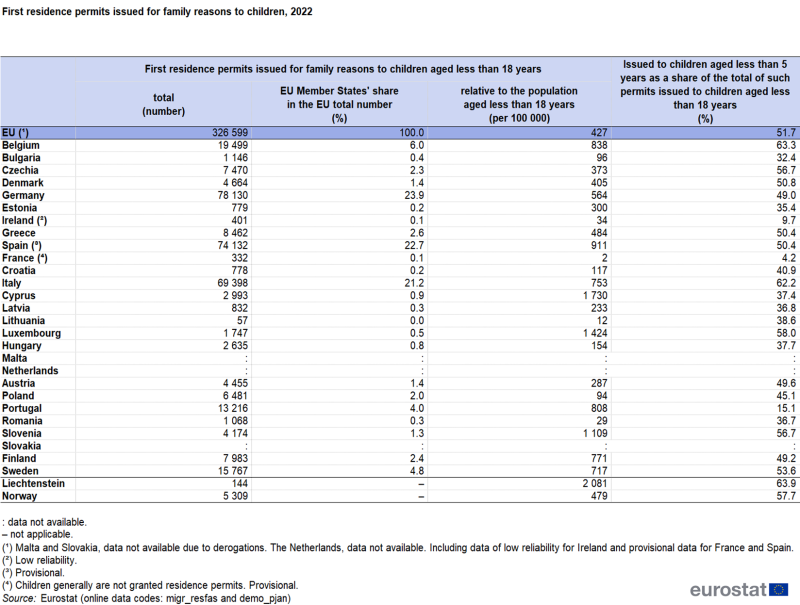
Source: Eurostat (migr_resfas) and (demo_pjan)
Developments during the period from 2012 to 2022
This section focuses on first residence permits granted to children under 15 years old for family reasons, as data for the age group 15-17 is only available in the years 2021 and 2022. To enhance comparability across different time periods and among EU Member States (and other countries), the data is presented as a ratio per 100,000 population under 15 years of age. The EU total for each year is calculated based on available Member State data for that year; the data on the population aged less than 15 years used as the denominator for this ratio are calculated based on the same availability of Member States as for the data on first residence permits.
As shown in Figure 2, the ratio for first residence permits issued in the EU to children for family reasons followed a downward path from 2012 to 2013. It stabilised in 2014 before increasing in 2015 and each year through until 2019. In 2020, there was a sharp fall, at least in part explained by the COVID-19 pandemic and related restrictions, for example on international travel. In 2021, the ratio rebounded to a level close to that observed in 2019. In 2022, the ratio went up to the highest level since the beginning of the presented time series. This means more children got residence permits for family reasons in the EU in 2022 than in any year since 2012. Over the whole period shown in Figure 2, this ratio ranged between a low of 266 permits per 100 000 population aged less than 15 years and a high of 467. By comparison, the same ratio calculated for first-time asylum applicants by children aged less than 18 years varied (in the period 2014–2022) between a low of 159 in 2020 and a high of 461 in 2016.
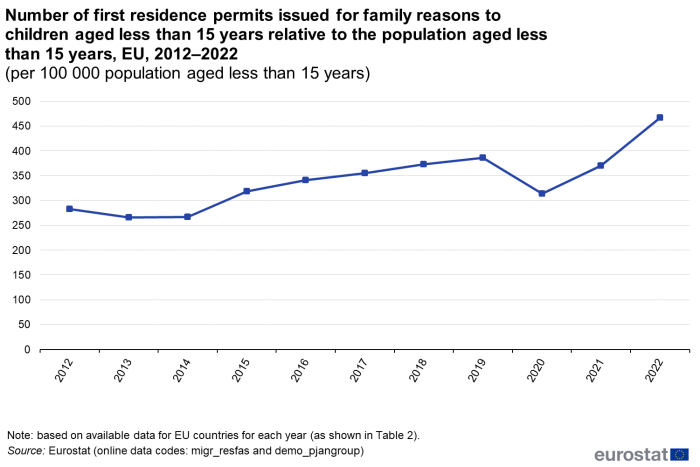
(per 100 000 population aged less than 15 years)
Source: Eurostat (migr_resfas) and (demo_pjangroup)
In Figure 3, the circular marker shows the highest (maximum) value of the ratio of the number of first residence permits issued for family reasons to children aged less than 15 years relative to the population aged less than 15 years for any year from 2012 to 2022; the lowest (minimum) value is indicated by the green square marker. The distance between these two markers (shown by the vertical grey bar) indicates the range observed over the whole period. The differences between the maximum and minimum values recorded between 2012 and 2022 in Slovenia (a range of 870 permits per 100 000) and Sweden (851) were 4 times as high as the range recorded for the EU average (201 per 100 000); an even greater range was observed for Cyprus (1 618 per 100 000).
Figure 3 also includes a blue circular marker to show the latest value of the same ratio and a red line for the average from 2012 to 2022. Within the figure, the Member States and EFTA countries have been classified in two groups, depending on whether their latest value for this ratio lies above or below their average for 2012 to 2022; within these two groups they have been ranked according to the average value. Most of the EU Member States are in the first group, indicating that the latest value of the ratio was above the average from 2012 to 2022. The reverse was observed for five Member States, most notably in Sweden, and to a lesser extent in Czechia, Latvia, Lithuania and Ireland; this was also the case in Norway and Switzerland.
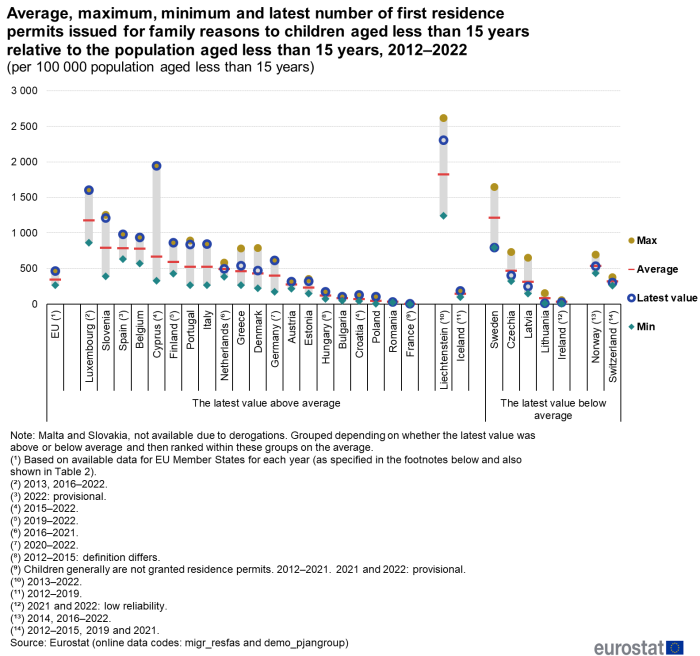
(per 100 000 population aged less than 15 years)
Source: Eurostat (migr_resfas) and (demo_pjangroup)
Focusing on the average for the period 2012 to 2022, relatively low ratios were observed in Bulgaria, Lithuania, Croatia (2015–2022), Poland, Romania, Ireland and France; in all of these, the national average was less than a quarter of the EU average (340 per 100 000). By contrast, ratios that were at least three times as high as the EU average were recorded in Luxembourg (2013 and 2016–2022) and Sweden; Liechtenstein also recorded a particularly high average ratio (2013–2022).
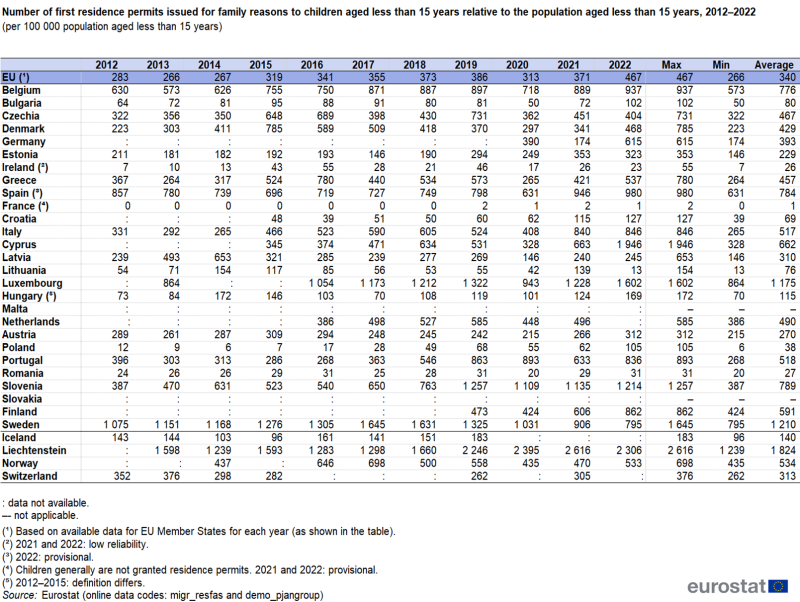
(per 100 000 population aged less than 15 years)
Source: Eurostat (migr_resfas) and (demo_pjangroup)
Analysis of countries of citizenship: EU overview
Figure 4 provides a summary analysis (at a continental level) of countries of citizenship of children aged less than 18 years issued first residence permits for family reasons in the EU in 2022. The total was 326 599, of which Asia (29.0 %), Europe (28.9 %) and Africa (25.9 %) collectively accounted for 83.7 %. Central and South America and the Caribbean (11.7 %) and North America (1.9 %) collectively accounted for 13.6 %. The share of children aged less than 18 years who were citizens of countries of Oceania (0.1 %) was very low as was the share of children who were stateless (0.2 %; 526 permits). The share with unknown citizenship was 2.4 % (7 835 permits).
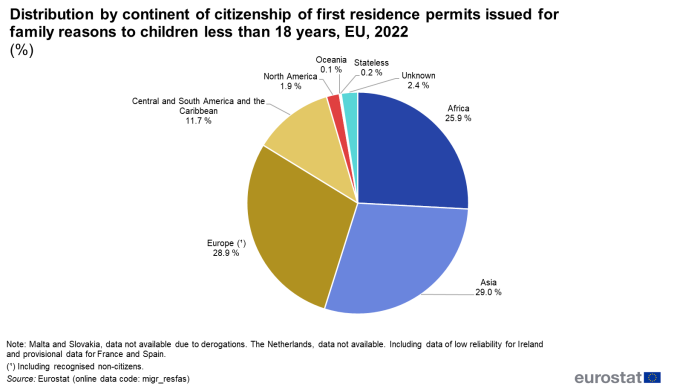
(%)
Source: Eurostat (migr_resfas)
Table 3 provides similar information to that in Figure 4 but includes also the top five countries of citizenship for the four continents with the largest shares.
- For Africa, the main country of citizenship was Morocco; its citizens aged less than 18 years received 39 569 first residence permits for family reasons in the EU in 2022, equivalent to 12.1 % of the overall total.
- For Asia, India (5.6 % of the total for all countries of citizenship) was the country with the highest number of citizens aged less than 18 years having been issued a first residence permit for family reasons in the EU in 2022; the next highest was Syria (4.4 %).
- For Europe, Albania (6.0 %) and Ukraine (5.1 %) were the two main countries whose citizens aged less than 18 years had been issued a first residence permit for family reasons in the EU in 2022.
- For Central and South America and the Caribbean, Brazil (3.1 %) recorded the largest number of its citizens aged less than 18 years having been issued a first residence permit for family reasons in the EU in 2022.
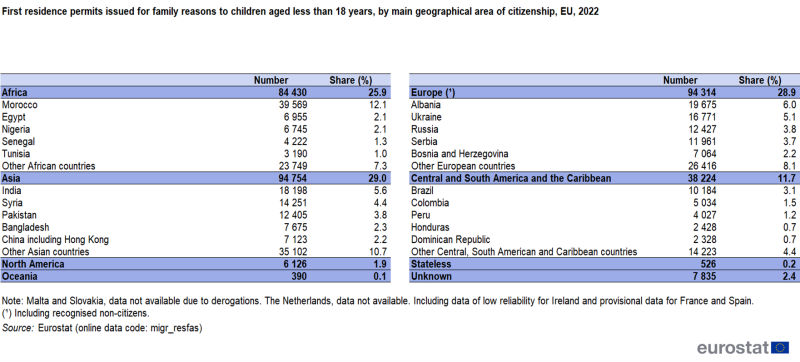
Source: Eurostat (migr_resfas)
Table 4 shows a simple list of the countries of citizenship with the highest number of children aged less than 18 years having been granted a first residence permit for family reasons in the EU in 2022. Alongside the category of unknown citizenship, the 19 countries shown consisted of seven European countries, six Asian countries, three African countries, Brazil and Colombia from Central and South America and the Caribbean and the United States from North America.
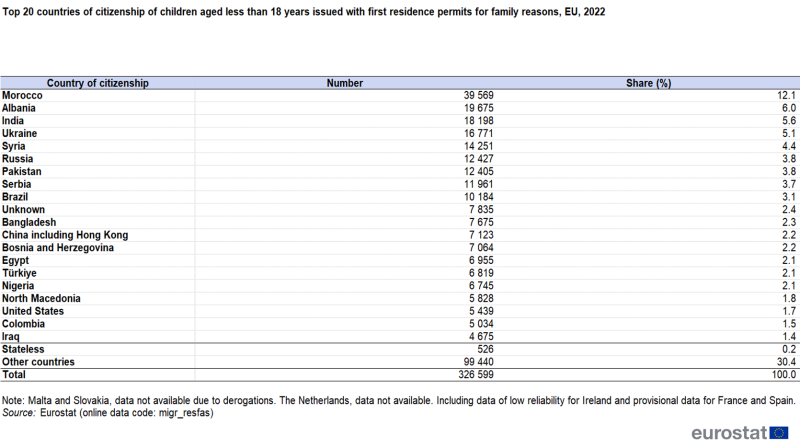
Source: Eurostat (migr_resfas)
EU Member States as destinations
Some of the factors that may influence the destination chosen by non-EU citizens who are granted residence permits include:
- geographical proximity (for example, a high number of Moroccans sought residence in Spain);
- historical and linguistic links (for example, a high number of Brazilians, Angolans and Cape Verdeans sought residence in Portugal);
- established migrant networks (for example, a high number of citizens of Türkiye sought residence in Germany).
Table 5 contains a selection of the 10 largest countries of citizenship of children aged less than 18 years issued with first residence permits for family reasons. Each country shows the three largest EU Member States destinations in 2022 as well as a residual total for all other Member States. Table 6 reverses the perspective, showing for each EU Member State the five main countries of citizenship as well as a residual for all other countries of citizenship. The relative share of the residuals in each of these tables give an idea of the geographical diversity of flows related to the issuance of first residence permits for family reasons to children between country of citizenship and the host Member States.
When looking at the destination of children aged less than 18 years from the top 10 countries of citizenship in Table 5, the category of other Member States (as the destination) is below one-third (33.3 %) in six countries of citizenship – Morocco, Albania, Syria, Pakistan, Serbia and Brazil – as well as for the unknown country of citizenship. This indicated that their target destination focuses on a relatively small number of Member States. In the case of Syria, it can be noted that the top three destinations include Germany, Sweden and Belgium, each of which received a large share of Syrian asylum applicants during the migration crisis in 2015–2016. By contrast, the level of the residual category was highest for Russian children (at 48.5 % respectively), indicating a more diversified breakdown by country of destination.
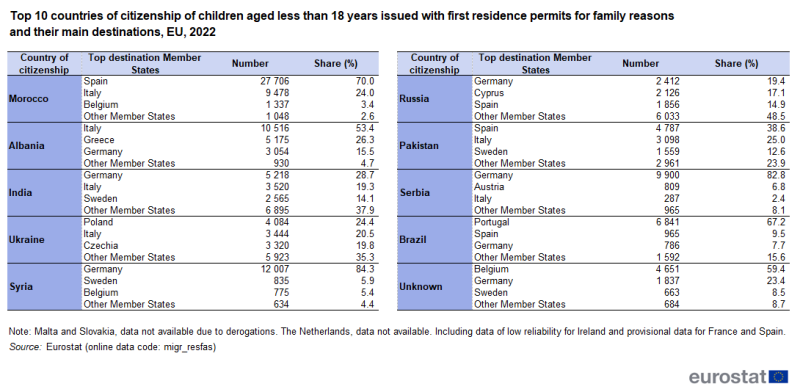
Source: Eurostat (migr_resfas)
By applying the same reasoning based upon the level of the other countries category, Table 6 provides information on the diversity of the citizenship of children issued with a first residence permit for family reasons in each EU Member State.
- In seven Member States – Belgium, Germany, France, Italy, Luxembourg, Finland and Sweden – the share of the residual category was above half (50.0 %).
- By contrast, also in seven Member States – Czechia, Greece, Cyprus, Latvia, Lithuania, Poland and Slovenia – the share of the residual category was below one-quarter (25.0 %).
Table 6 also reflects some specific links (such as economic, historical or proximity). For example, in Greece a high share of the first residence permits issued to children aged less than 18 years for family reasons were for Albanians (61.2 % of the Greek total). Equally, there were large shares for Russians (71.0 %) in Cyprus, Ukrainians (63.0 %) in Poland and Brazilians (51.8 %) in Portugal .
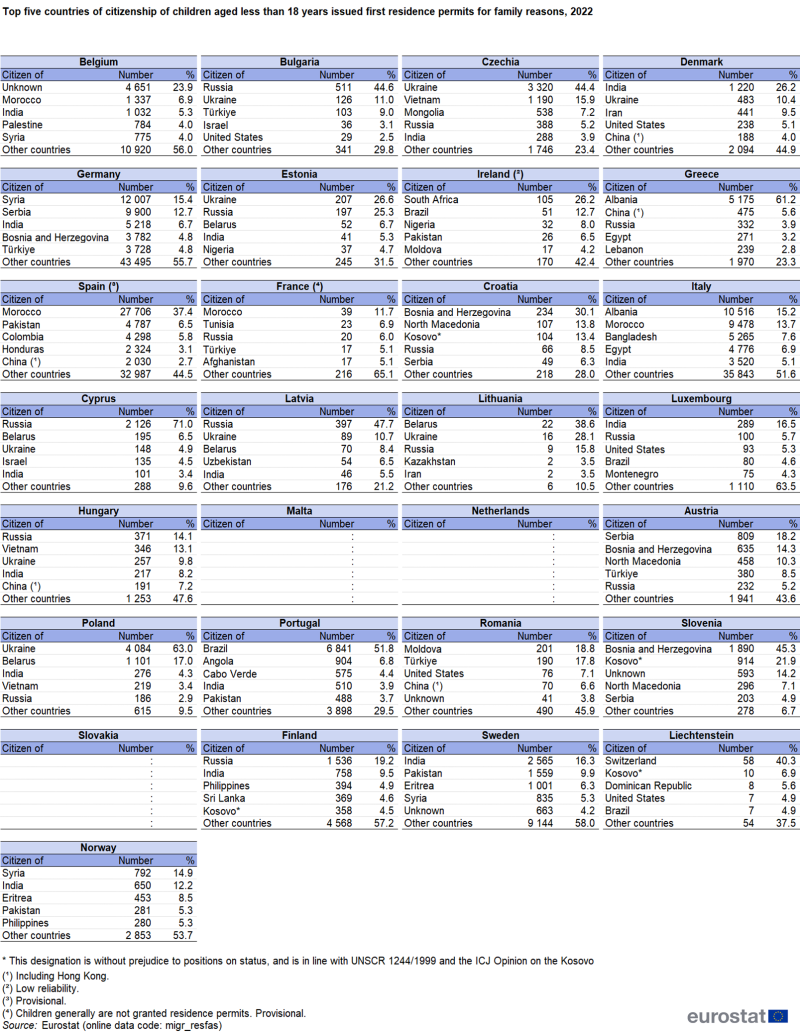
Source: Eurostat (migr_resfas)
Source data for tables and graphs
Data sources
Residence permits statistics
The statistics used for this article are provided to Eurostat by the responsible authorities in each of the EU Member States and EFTA countries, principally ministries of the interior / home affairs or various immigration agencies. The data are based entirely on administrative sources and are supplied to Eurostat as part of an annual residence permits data collection exercise according to the provisions of Article 6 of Regulation (EC) No 862/2007 on Community statistics on migration and international protection. Commission Regulation (EU) No 216/2010 on Community statistics on migration and international protection, as regards the definitions of categories of the reasons for the residence permits, provides the list and definition of reasons for permits being issued.
Before the 2021 reference year, the analysis by age of the number of first residence permits was reported by EU Member States and EFTA countries on a voluntary basis. Starting with the 2021 reference period, there were several improvements in the data collection, including the methodological aspects. These changes were introduced through the implementation of Regulation (EU) 851/2020 amending Regulation (EC) 862/2007. More details are available in the following document: 2021 Residence Permits Technical Guidelines.
Methodological notes
Data on residence permits are based on administrative and judicial decisions and, therefore, not directly comparable with international migration statistics [2] which are based on the concept of 'permanent residence' and include intra-EU immigration flows, the number of births and deaths of migrant population as well as emigration flows.
The EU totals presented in this article are calculated as the sum of the available data for EU Member States. Data for Malta and Slovakia not available due to derogations.
The data for France are relatively low in value as, in most cases, France does not issue residence permits to children aged less than 18 years and the minors who arrive can stay in France without a permit.
The "u" flag in Irish residence permit data highlights limited data quality reported by the Irish authorities. For the process of generating resident permits data that involves both the Irish Police and the Department of Justice an old information system is currently being used. The current system's limitations, which misses unique identifier of persons, require manual data checks, which may lead to potential quality issues. According to Irish authorities a comprehensive modernization programme of the information systems to ensure more accurate data management is in progress.
Context
The term 'children in migration' covers all children (persons aged less than 18 year) who are a) not citizens of an EU Member State and b) forcibly displaced or migrate to and within the EU. They may be with their (extended) family, with a non-family member (separated children) or alone; they may or may not be seeking asylum.
In recent years, the number of children in migration arriving in the EU, many of whom are unaccompanied, has increased dramatically, particularly in 2015 and 2016. Besides asylum applicants, a substantial number of non-EU children migrate for family reasons.
Protecting children is primarily about upholding European values of respect for human rights, dignity and solidarity. This is why protecting all children in migration, regardless of status and at all stages of migration, is a priority. The EU Member States and the EU, with the support of the relevant EU agencies (European Border and Coast Guard Agency; European Asylum Support Office (EASO) and the European Union Agency for Fundamental Rights (FRA)), have been active in this area for many years. The existing EU policies and legislation provide a solid framework for the protection of the rights of children in migration covering all aspects including reception conditions, the treatment of their applications and integration.
The protection of children in migration starts by addressing the root causes which lead so many to embark on perilous journeys to Europe. This means addressing the persistence of violent and often protracted conflicts, forced displacements, inequalities in living standards, limited economic opportunities, and access to basic services through sustained efforts to eradicate poverty and deprivation and to develop integrated child protection systems in non-EU countries. The EU and the Member States have stepped up efforts to establish a comprehensive external policy framework to reinforce cooperation with partner countries in mainstreaming child protection at global, regional and bilateral levels. The EU is fully committed to implement the 2030 Agenda for Sustainable Development, which calls for a world in which all children grow up free from violence and exploitation, have their rights protected and have access to quality education and health care. The 2015 Valletta Summit's political declaration and its action plan called for the prevention of and the fight against irregular migration, migrant smuggling and trafficking in human beings (with a specific focus on women and children).
In the EU Guidelines on the Promotion and Protection of the Rights of the Child renew the EU's commitment to promote and protect the indivisibility of the rights of the child in its relations with non-EU countries, including countries of origin or transit. In this context, the Council reaffirmed the need to protect all refugee and migrant children, regardless of their status, and give primary consideration at all times to the best interests of the child, including unaccompanied children and those separated from their families, in full compliance with the UN Convention on the Rights of the Child and its optional protocols. In April 2021, the European Commission presented a new EU Strategy on Combatting Trafficking in Human Beings (2021–2025).
Within the European Commission, the Directorate-General for Migration and Home Affairs is responsible for immigration policy, whereas the Directorate-General for Justice and Consumers is in charge of child policy. All information regarding the EU's migration and asylum policies can be accessed on the European Commission's website. Recent developments for the EU's overall immigration policy can be found in the New Pact on Migration and Asylum.
Notes
- ↑ See the database migr_asyappctza.
- ↑ See the summary of methodology for demography, population stock and balance.
Direct access to